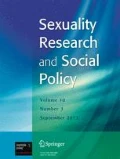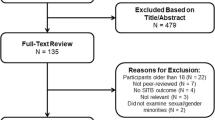Abstract
International research has demonstrated that lesbian, gay, bisexual and transgender (LGBT) youth have elevated rates of suicide and self-harm. What is missing from the evidence base, however, is qualitative research investigating LGBT youth perspectives. This is a sensitive subject area presenting ethical, methodological and epistemological challenges, especially in relation to over-sampling the ‘visible’ sections of a hidden population, retrospective reporting, and capturing complex emotions. We report on our use of qualitative online methodology to examine Internet forums where LGBT youth discuss self-harming. We found that this methodology can address some research dilemmas by generating: (a) diverse samples in terms of sexuality and gender identities; (b) a different type of data, immediate and unmediated by researchers; and (c) complex psychosocial emotional data. We argue that this online data can enhance our understanding of the links among hard-to-reach youth, suicide, self-harm, sexuality and gender, which is crucial to developing effective and appropriate suicide prevention strategies and mental health policies.
Similar content being viewed by others
Notes
We use the term self-harm here to include suicidality and self-harm.
References
Alexander, N., & Clare, L. (2004). You still feel different: The experience and meaning of women’s self-injury in the context of a lesbian or bisexual identity. Journal of Community & Applied Social Psychology, 14(2), 70–84. doi:10.1002/casp.764.
Baker, D., & Fortune, S. (2008). Understanding self-harm and suicide websites: A qualitative interview study of young adult website users. Crisis, 29(3), 118–122. doi:10.1027/0227-5910.29.3.118.
Barker, K. K., & Galardi, T. R. (2011). Dead by 50: Lay expertise and breast cancer screening. Social Science & Medicine, 72(8), 1351–1358.
Blank, G. (2008). Online research methods and social theory. In N. Fielding, R. Lee, & G. Blank (Eds.), The SAGE Handbook of Online Methods (pp. 537–549). London: Sage.
British Psychological Society. (2007). Report of the working party on conducting research on the internet: Guidelines for ethical practice in psychological research online. The British Psychological Society, Leicester. Retrieved from http://www.bps.org.uk/sites/default/files/documents/conducting_research_on_the_internet-guidelines_for_ethical_practice_in_psychological_research_online.pdf
Caspi, A., & Gorsky, P. (2006). Online deception: Prevalence, motivation, and emotion. Cyberpsychology & Behavior, 9(1), 54–59. doi:10.1089/cpb.2006.9.54.
D’Augelli, A. R. (2002). Mental health problems among lesbian, gay, and bisexual youths ages 14 to 21. Clinical Child Psychology and Psychiatry, 7(3), 433–456. doi:10.1177/1359104502007003010.
D’Augelli, A. R. (2003). Lesbian and bisexual female youths aged 14 to 21: Developmental challenges and victimization experiences. Journal of Lesbian Studies, 7(4), 9–29. doi:10.1300/J155v07n04_02.
D’Augelli, A. R., Grossman, A. H., Salter, N. P., Vasey, J. J., Starks, M. T., & Sinclair, K. O. (2005). Predicting the suicide attempts of lesbian, gay, and bisexual youth. Suicide & Life-Threatening Behavior, 35(6), 646–660. doi:10.1521/suli.2005.35.6.646.
Dempsey, D., Hillier, L., & Harrison, L. (2001). Gendered (s)explorations among same-sex attracted young people in Australia. Journal of Adolescence, 24(1), 67–81. doi:10.1006/jado.2000.0363.
Ellison, N. B., Steinfield, C., & Lampe, C. (2007). The benefits of Facebook “friends:” Social capital and college students’ use of online social network sites. Journal of Computer-Mediated Communication, 12(4), 1143–1168. doi:10.1111/j.1083-6101.2007.00367.x.
Fenaughty, J., & Harre, N. (2003). Life on the seesaw: A qualitative study of suicide resiliency factors for young gay men. Journal of Homosexuality, 45(1), 1–22. doi:10.1300/J082v45n01_01.
Flowers, P., & Buston, K. (2001). 'I was terrified of being different': Exploring gay men’s accounts of growing-up in a heterosexist society. Journal of Adolescence, 24(1), 51–65. doi:10.1006/jado.2000.0362.
Fullagar, S. (2003). Wasted lives. Journal of Sociology, 39(3), 291–307. doi:10.1177/0004869003035076.
Fullagar, S. (2005). The paradox of promoting help-seeking: A critical analysis of risk, rurality and youth suicide. International Journal of Critical Psychology, 14, 31–51.
Gilbert, P. (1997). The evolution of social attractiveness and its role in shame, humiliation, guilt and therapy. The British Journal of Medical Psychology, 70(2), 113–147. doi:10.1111/j.2044-8341.1997.tb01893.x.
Gray, M. L. (2009a). Negotiating identities/queering desires: Coming out online and the remediation of the coming-out story. Journal of Computer-Mediated Communication, 14(4), 1162–1189. doi:10.1111/j.1083-6101.2009.01485.x.
Gray, M. L. (2009b). Out in the country: Youth, media and queer bisibility. New York: New York University Press.
Haas, A. P., Eliason, M., Mays, V. M., et al. (2011). Suicide and suicide risk in lesbian, gay, bisexual, and transgender populations: Review and recommendations. Journal of Homosexuality, 58(1), 10–51. doi:10.1080/00918369.2011.534038.
Hawton, K., Rodham, K., & Evans, E. (2006). By their own hand: Deliberate self-harm and suicidal ideas in adolescents. London: Jessica Kingsley.
Hegna, K., & Wichstrøm, L. (2007). Suicide attempts among Norwegian gay, lesbian and bisexual youths: General and specific risk factors. Acta Sociologica, 50(1), 21–37. doi:10.1177/0001699307074880.
Hillier, L., & Harrison, L. (2004). Homophobia and the production of shame: Young people and same sex attraction. Culture Health & Sexuality, 6(1), 79–94. doi:10.1080/13691050310001611156.
Hillier, L., & Harrison, L. (2007). Building realities less limited than their own: Young people practising same-sex attraction on the Internet. Sexualities, 10(1), 82–100. doi:10.1080/13691050310001611156.
Hillier, L., & Rosenthal, D. (2001). Special issue on gay, lesbian and bisexual youth. Journal of Adolescence, 24(1), 1–4. doi:10.1006/jado.2000.036810.1006.
Hillier, L., Harrison, L., Dempsey, D., & Nieto, J. A. (2004). “It made me feel braver, I was no longer alone”: Same-sex Attracted young people exploring the pleasures and pitfalls of the Internet. InJ. Nieto (Ed.), Sexuality in the Pacific (pp. 79–100). Madrid: Spanish Association of Studies in the Pacific.
Hine, C., Kendall, L., & Boyd, D. (2009). Question one: How can qualitative Internet researchers define the boundaries of their projects? In A. Markham & N. Baym (Eds.), Internet inquiry: Conversations about method (pp. 1–32). London: Sage.
HM Government. (2012). Preventing suicide in England: A cross-government outcomes strategy to save lives. London: HMG/DH.
Horne, J., & Wiggins, S. (2009). Doing being 'on the edge': Managing the dilemma of being authentically suicidal in an online forum. Sociology of Health & Illness, 31(2), 170–184. doi:10.1111/j.1467-9566.2008.01130.x.
Hunt, R., & Fish, J. (2008). Prescription for change: Lesbian and bisexual women’s health check. London: Stonewall and De Montfort University. Retrieved from http://www.stonewall.org.uk/documents/prescription_for_change.pdf
King, M., Semlyen, J., See Tai, S., Killaspy, H., et al. (2007). Mental disorders, suicide, and deliberate self harm in lesbian, gay and bisexual people: A systematic review. BMC Psychiatry, 8. doi:10.1186/1471-244X-8-70.
Kozinets, R. (2010). Netnography: Doing ethnographic research online. London: Sage.
Lu, H.-Y. (2008). Sensation-Seeking, internet dependency, and online interpersonal deception. Cyberpsychology & Behavior, 11(2), 227–231. doi:10.1089/cpb.2007.0053.
Mann, C., & Stewart, S. (2000). Internet communication and qualitative research: A handbook for researching online. London: Sage.
Martin, J. I., & D’Augelli, A. R. (2009). Timed lives: Cohort and period effects in research on sexual orientation and gender identity. In W. Meezan & J. I. Martin (Eds.), Handbook of research with lesbian, gay, bisexual, and transgender populations (pp. 190–207). New York: Routledge.
Mason, J. (2002). Qualitative Researching. London: Sage.
McDermott, E. (2011). Multiplex methodologies: Researching young people’s well-being at the intersections of class, sexuality, gender and age. In Y. Taylor, S. Hines & C. Casey (Eds.), Theorising intersectionality and sexuality (pp. 235–254). Palgrave Macmillan.
McDermott, E., & Roen, K. (2012). Youth on the ‘virtual’ edge: Researching marginalized sexualities and genders online. Qualitative Health Research, 22(4), 560–570.
McDermott, E., Roen, K., & Scourfield, J. (2008). Avoiding shame: Young LGBT people, homophobia and self-destructive behaviours. Culture, Health & Sexuality, 10(8), 815–829.
Markham, A., & Buchanan, E. (2012). Ethical decision-making and Internet research 2.0: Recommendations from the aoir ethics working committee. Association of the Internet Research Ethics Working committee. http://www.aoir.org/reports/ethics2.pdf. Accessed 14 Jan 2013.
Meezan, W., & Martin, J. I. (2003). Exploring current themes in research on gay, lesbian, bisexual and transgender populations. In W. Meezan & J. I. Martin (Eds.), Research methods with gay, lesbian, bisexual and transgender populations (pp. 1–14). New York: Harrington Park Press.
Mitchell, M., Howarth, C., Kotecha, M., & Creegan, C. (2009). Sexual orientation research review 2008. London: NatCen. Retrieved from http://www.equalityhumanrights.com/uploaded_files/sexual_orientation_research_review.pdf
Munt, S. (2000). Shame/pride dichotomies in Queer As Folk. Textual Practice, 14(3), 531–546. doi:10.1080/095023600750040694.
Pilkington, N. W., & D’Augelli, A. R. (1995). Victimization of lesbian, gay, and bisexual youth in community settings. Journal of Community Psychology, 23(1), 33–56. doi:10.1002/1520-6629(199501)23:1<34::AID-JCOP2290230105>3.0.CO;2-N.
Ploderl, M., Faistauer, G., & Fartacek, R. (2010). The contribution of school to the feeling of acceptance and the risk of suicide attempts among Austrian gay and bisexual Males. Journal of Homosexuality, 57(7), 819–841. doi:10.1080/00918369.2010.493401.
Probyn, E. (2005). Blush: Faces of shame. Minneapolis: University of Minnesota Press.
Pullen, C., & Margaret, C. (Eds.). (2010). LGBT Identity and Online New Media. London: Routledge.
Redley, M. (2003). Towards a new perspective on deliberate self-harm in an area of multiple deprivation. Sociology of Health & Illness, 25(4), 348–373. doi:10.1111/1467-9566.00350.
Reed, A. (2005). “my blog is me”: Text and persons in UK online journal culture (and anthropology). Ethnos, 70(2), 220–42. doi:10.1080/00141840500141311
Rivers, I., & Cowie, H. (2006). Bullying and homophobia in UK schools: A perspective on factors affecting resilience and recovery. Journal of Gay & Lesbian Issues in Education, 3(4), 11–43.
Savin-Williams, R. C., & Ream, G. L. (2003). Suicide attempts among sexual-minority male youth. Journal of Clinical Child and Adolescent Psychology, 32(4), 509–522. doi:10.1207/S15374424JCCP3204_3.
Scheff, T. J. (2003). Shame in self and society. Symbolic Interaction, 26(2), 239–262. doi:10.1525/si.2003.26.2.239.
Scourfield J., Roen, K., & McDermott, E. (2008). Lesbian, gay, bisexual and transgender young people’s experiences of distress: resilience, ambivalence and self-destructive behaviour. Health and Social Care in the Community 16(3), 329–336.
Silenzo, V., Duberstein, P., Tang, W., et al. (2009). Connecting the invisible dots: Reaching lesbian, gay bisexual adolescents and young adults at risk from suicide through online social networks. Social Science & Medicine, 69, 469–474. doi:10.1016/j.socscimed.2009.05.029.
Sveningsson Elm, M., Buchanan, E., & Stern, S. (2009). Question three: How do various notions of provacy influence decisions in qualitative Internet research? In A. N. Markham & N. K. Baym (Eds.), Internet inquiry: Conversations about method (pp. 69–98). London: Sage.
Valentine, G., Skelton, T., & Butler, R. (2002). The vulnerability and marginalisation of lesbian and gay youth: Ways forward. Youth and Policy, 75, 4–29.
Vanden Berghe, W., Dewaele, A., Cox, N., & Vincke, J. (2010). Minority-specific determinants of mental well-being among lesbian, gay, and bisexual youth. Journal of Applied Social Psychology, 40(1), 153–166. doi:10.1111/j.1559-1816.2009.00567.x.
Webb, M., Burns, J., & Collin, P. (2008). Providing online support for young people with mental health difficulties: Challenges and opportunities explored. Early Intervention in Psychiatry, 2(2), 108–113. doi:10.1111/j.1751-7893.2008.00066.x.
Whittle, S., Turner, L., & Al-Alami, M. (2007). Engendered penalties: Transgender and transsexual people’s experiences of inequality and discrimination. London: Communities and Local Government Publications.
Whitty, M. T. (2003). Cyber-flirting: Playing at love on the Internet. Behaviour Change, 21(2), 115–126. doi:10.1177/0959354303013003003.
Wilkinson, D., & Thelwall, M. (2011). Researching personal information on the public web: Methods and ethics. Social Science Computer Review, 29(4), 387–401. doi:10.1177/0894439310378979.
Willis, P. (2011). Talking sexuality online—Technical, methodological and ethical considerations of online research with sexual minority youth. Qualitative Social Work, 11(2), 141–155. doi:10.1177/1473325011400488.
Acknowledgements
This work was supported by the British Academy Small Research Grant.
Author information
Authors and Affiliations
Corresponding author
Rights and permissions
About this article
Cite this article
McDermott, E., Roen, K. & Piela, A. Hard-to-Reach Youth Online: Methodological Advances in Self-Harm Research. Sex Res Soc Policy 10, 125–134 (2013). https://doi.org/10.1007/s13178-012-0108-z
Published:
Issue Date:
DOI: https://doi.org/10.1007/s13178-012-0108-z




